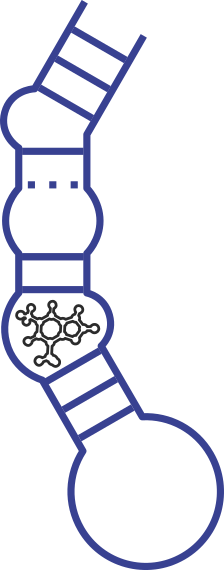Difference between revisions of "Template:Heidelberg/pages/overview/aptamers"
| Line 12: | Line 12: | ||
<div class="panel‐body"> | <div class="panel‐body"> | ||
<div class="row"> | <div class="row"> | ||
| − | <div class="col-lg- | + | |
| − | + | <div class="col-lg-2" style="margin-top:-25px;"> | |
<div class="imagewrapper"> | <div class="imagewrapper"> | ||
<div class="imagewrapperheader"> | <div class="imagewrapperheader"> | ||
| Line 36: | Line 36: | ||
Both catalytic nucleic acids and aptamers are as for today selected via systematic evolution of ligands by exponential enhancement<x-ref>Joyce1989</x-ref><x-ref>ellington1990</x-ref><x-ref>tuerk1990</x-ref><x-ref>bartel1993</x-ref> also known as SELEX (Fig. 5). It is a very time consuming and expensive process. Many cycles of selection from a random pool of sequences have to be performed in order select the best candidates in each round. A variable starting pool of random sequences has to be prepared and after every cycle the candidates have to be mutated to further improve the binding to the target. All in all the process is rather inefficient. Probably this is the reason why there are still many small molecules and proteins for which no aptamer has been published yet. | Both catalytic nucleic acids and aptamers are as for today selected via systematic evolution of ligands by exponential enhancement<x-ref>Joyce1989</x-ref><x-ref>ellington1990</x-ref><x-ref>tuerk1990</x-ref><x-ref>bartel1993</x-ref> also known as SELEX (Fig. 5). It is a very time consuming and expensive process. Many cycles of selection from a random pool of sequences have to be performed in order select the best candidates in each round. A variable starting pool of random sequences has to be prepared and after every cycle the candidates have to be mutated to further improve the binding to the target. All in all the process is rather inefficient. Probably this is the reason why there are still many small molecules and proteins for which no aptamer has been published yet. | ||
</p> | </p> | ||
| + | </div> | ||
| + | |||
<div class="col-lg-6"> | <div class="col-lg-6"> | ||
<div class="imagewrapper"> | <div class="imagewrapper"> | ||
Revision as of 01:09, 19 September 2015
Aptamers

Aptamers are RNA or DNA sequences that can selectively bind to a ligand or target. Scientists have selected a variety of aptamers for small molecules ranging from theophylline (Fig. 4A) being one of the first described aptamers
Both catalytic nucleic acids and aptamers are as for today selected via systematic evolution of ligands by exponential enhancement

Systematic Evolution of Ligands by EXponential Enrichment (SELEX): Current method to select functional nucleic acids from a random library. Figure adapted from :Source
It has been shown that selected aptamers can be used to make the catalytic activity dependent on the presence of a ligand.

An aptamer connected via a communication module to an catalytic sequence; The communication module translates the interaction of the ligand with the aptamer to the catalytic part of the aptazyme.
Besides the above describes functional nucleic acids SELEX revealed aptamers which not only bind to a ligand but also are able to turn on fluorescence of different non-fluorescent dyes. An interesting example for an aptamer with such a special function is the Malachite Green Aptamer.

The Spinach Aptamer turns on fluorescence of its ligand upon bind it.
Though we so far mainly discussed functional RNA there are also both DNA aptamers and catalytic DNA which were selected using SELEX as well. As for today the concept of functional nucleic acids in nature has only been found for RNA. Nevertheless DNA aptamers and also catalytic DNA were selected in vitro.